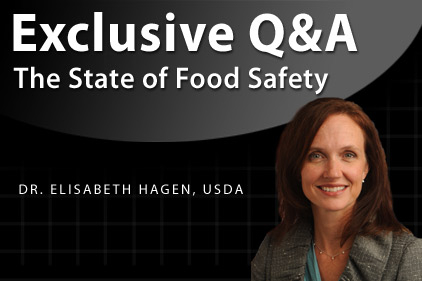As the 2012 calendar year comes to an end, The National Provisioner sits down with Dr. Elisabeth Hagen, USDA Under Secretary for Food Safety, to assess the state of food safety in the meat- and poultry-processing industries. We bring you this Q&A in conjunction with our year-end coverage, starting in October with our State of the Industry report and continuing through November with our 2013 Consumer Trends report. To read these articles, simply click on their titles to be directed to them here on our site.
NP: Will the new testing for Shiga toxin-producing E. coli (STECs) be sufficiently effective to reduce illnesses from these strains of E. coli?

|
| Photo courtesy of USDA |
| Dr. Elisabeth Hagen, USDA Under Secretary for Food Safety |
Hagen: We are continually evaluating and improving our policies to make sure that we are using all available tools to prevent foodborne illness. When it comes to pathogens like STEC, we need to stay ahead of the curve. We’re confident that targeting additional STECS now can prevent them from becoming a larger public-health issue later.The STECs we are now focused on are responsible for more than 112,000 illnesses annually. The results of our testing efforts for the STECs are encouraging. As of October 14, 2012, the number of positive samples for raw ground beef components was 2.36% (31 out of 1,311 samples analyzed).* It’s still early, and by testing and sampling, we will learn more about STECs and focus prevention efforts accordingly. That said, the zero-tolerance policy will help us keep these dangerous pathogens from harming consumers.
NP: How is the USDA’s new Public Health Information System (PHIS) performing so far?
Hagen: PHIS is a tremendous resource in that it is making FSIS’ prevention efforts much more proactive instead of reactive. Now, FSIS inspectors can look at what’s occurring in an establishment in real time and find out right away how plants are performing. They have more information at their fingertips and can get a more accurate picture for what is going on in an establishment a lot sooner. PHIS represents a long-term effort on the agency’s part to promote efficiency and greatly improve the quality and quantity of data it collects and analyzes to prevent foodborne illnesses. It’s been an ambitious undertaking, and FSIS is acquiring a great deal of data that it did not have before. We will continue to strengthen and enhance PHIS to achieve what we set out to accomplish in our Strategic Plan, such as ensuring our inspection activities align with existing and emerging risks, and that our policies are effectively responding to the risks we identify.
NP: What is the current status of the proposed new regulations for poultry slaughter?
Hagen: The agency received an abundance of feedback on this proposal. We’re in the process of reviewing and evaluating all of the comments we received earlier this year. We will only put forward a final rule if we’re confident it will bolster food safety.
NP: USDA-FSIS recently announced changes to its Listeria monocytogenes (Lm) product sampling programs in ready-to-eat meat and poultry products. Please explain the background behind the changes to these procedures. How will they directly affect processors?
Hagen: The changes won’t affect processors directly because there are no new requirements or regulations associated with them. What the changes will do is help FSIS reduce the number of illnesses and deaths caused by Listeria monocytogenes in ready-to-eat foods. Once they are implemented, FSIS will be conducting more accurate testing, increasing the potential for detecting any Lm present. The changes will also help bring FSIS’ testing practices more in line with those done internationally and will reduce costs associated with analyzing samples.
NP: How far will USDA-FSIS go with regard to lowering the Salmonella standards for poultry? How about Campylobacter?
Hagen: Last year, we announced tougher performance standards for Salmonella and new ones for Campylobacter. Everyone agrees that these are stringent: For Salmonella, they went from 20% to 7.5%. This set a very high bar for industry to meet, and we expect the standards to have a significant effect, reducing the number of pathogens in poultry products and preventing 25,000 foodborne illnesses every year. That said, FSIS is constantly refining its protection measures based on what we’ve learned in the past, and we look forward to evaluating how effective these new standards have been.
NP: How would you assess how your team has handled so far your primary goals for the meat industry and FSIS, in terms of preventing foodborne illness?
Hagen: Our team — from our public-health scientists to our front-line inspectors — has one purpose: to protect consumers. I am proud of what we’ve been able to accomplish together, from new policies to combat foodborne pathogens, to our food-safety education efforts, to our labeling requirements that put more information in consumers’ hands. These actions have all underscored our commitment to preventing foodborne illness.
But we have more work to do. We have significant challenges ahead of us, and our team must continuallymodernize our processes — whether it be in testing, inspection — and find effective ways to communicate with and educate the public. We are using science and all the resources at our disposal to protect consumers and to prevent pathogens from causing foodborne illness — this will always be our primary focus.
In the past two years alone, this Administration announced or put in place numerous measures to safeguard the food supply, prevent foodborne illness, and improve consumers’ knowledge about the food they eat. We set performance standards for poultry to reduce the prospects of Salmonella and Campylobacter from harming people. We targeted the “Big 6” STECs — E. coli O26, O103, O45, 111, O121 and O145 — by drawing a line in the sand with our zero-tolerance policy. We announced Hold and Test, and once it is finalized, that action will help keep unsafe meat products from reaching consumers. FSIS developed labeling requirements so shoppers have better nutrition information available when they’re at the store buying meat and poultry products. And consumers with food-safety questions can get answers on their smartphones using the “Ask Karen from USDA” app, which is available in both English and Spanish formats.
*-- As noted at http://www.fsis.usda.gov/Science/RGBC_STEC_Results/index.asp#table2







